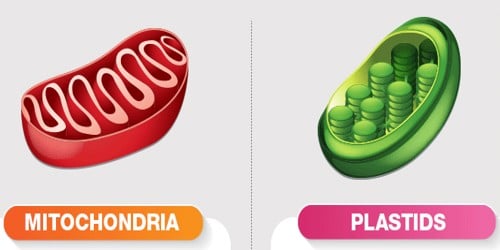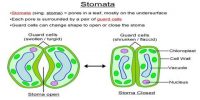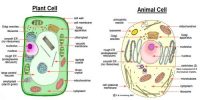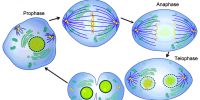The key difference between plastid and mitochondria is that plastids are found in plant cells and mitochondria are found in both plant and animal.
Difference between Mitochondria and Plastid:
Mitochondria – They are a type of organelles in which the biochemical processes of respiration and energy production happen.
- Pigments: Absent, mitochondria have lack pigments.
- Position: It is commonly present in both plant and animal cells. Found in all eukaryotic cells.
- Color: Mitochondria are the colorless organelles.
- Shape: Bean shape.
- Inner membrane: Inner membrane is inwardly many folded which are called crystae.
- Chamber: It is divided into complete chambers. Completely separated chambers are found inside the matrix.
- Function: It is the respiratory organ of the cell. They are mostly involved in energy production through cellular respiration. They are responsible for cellular respiration and energy metabolism.
- Food reserve: It does not store any food.
- Organelle DNA: Mitochondria have their own DNA inside the organelle.
- Types: Mitochondrial structure may vary based on the needs of the cell.

Plastid – They are double-membrane organelles found only in plants and algae in which production and storage of chemicals occur in the cell.
- Pigments: It has different pigments. There are many plastids contain pigments.
- Position: It is only found in the plant cell and algae.
- Color: The chloroplast is green in colors.
- Shape: Disc shape.
- Inner membrane: Folds are not found in the inner membrane.
- Chamber: Chambers are not found. Plasmids lack totally separated chambers inside the matrix.
- Function: It is mainly an organelle involved in manufacturing food for the cell. They are mostly involved in food production and storage in the cell.
- Food reserve: Non pigmented plastid stores different food materials.
- Organelle DNA: Only chloroplasts have their own DNA
- Types: Leucoplasts, chromoplasts, and chloroplasts are the three types of plastids.

Fig: Plastid
Mitochondria and Plastids are very important cell organelles that perform different functions. Mitochondria also are known as ‘powerhouse of the cell’. They play a role in thermogenesis while plastids do not play a role in thermogenesis. Plastids are the sites of photosynthesis. They can be involved in glucose production by photosynthesis. Chloroplasts use and produce water during photosynthesis, while mitochondria only produce and do not form water during respiration.














